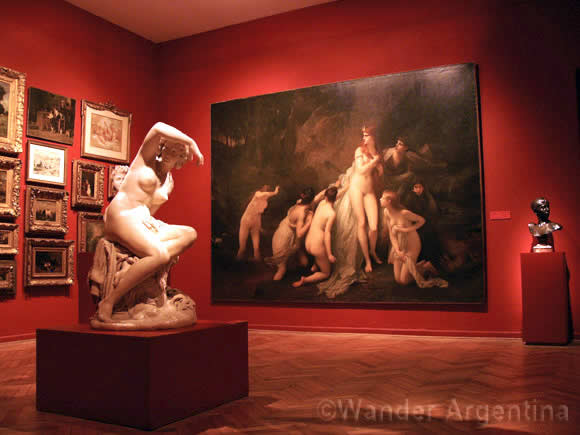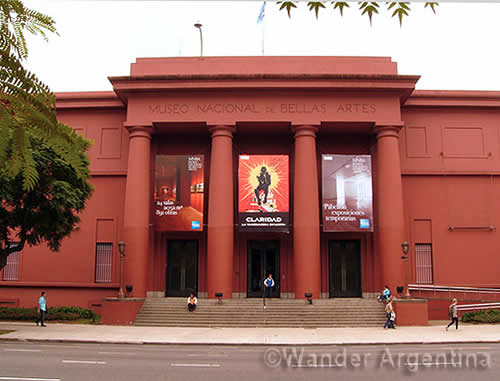The Museo Nacional de Bellas Artes (MNBA) is the home to Argentina’s largest national fine art collection.
Situated along the greenery of Libertador Avenue in the ritzy neighborhood of Recoleta, the National Fine Arts Museum 1870’s façade alludes to the primarily 19th century European pieces found inside.
Bella Artes is one of Argentina’s oldest museums and in contrast to the more modern Latin American Art Museum, MNBA has a vast permanent collection. There are 688 major works and 12,000 minor works, mostly donated by private collectors. The pieces are displayed on two floors of labyrinth-like rooms with a total of 34 exhibition halls.
Best of all for visitors on a budget, admission to this world-class museum is free .
European and international art from the middle ages to the 20th century make up much of the first floor with portrayals of female nudes splayed on grassy knolls and somber religious iconography. There are also pieces by Édouard Manet, Henri De Toulouse-Lautrec, Paul Cézanne, Vincent Van Gogh and Camille Pissarro, along with a room of Francisco De Goya.
A considerable amount of space is dedicated to decorative Spanish art and sculpture, revealing the genre’s popularity in Argentina at the end of the 19th century.
Argentine Arts and Temporary Exhibitions
The National Fine Arts Museum opened the contemporary Argentine art pavilion in 1980. Today MNBA houses the world’s largest collection of Argentine art with works by undervalued national artists such as Benito Quinquela Martín, Antonio Berni, Ernesto de la Cárcova, and Xul Solar.
Some of the museum highlights are Auguste Rodin’s sculpture, ‘The Kiss’; Pío Collivadino 1903 work, La Hora Del Almuerzo (The Lunch Break); Cárcova’s 1893 ‘Sin pan y sin trabajo’ (No Bread, No Work); and ‘Two Dancers in Red and Yellow’ by Degas.
Works by Jackson Pollack and three whimsical pieces by optical and kinetic artist, Martha Boto demonstrate the acquisitions department’s desire to round out their collection with an array of international contemporary works from recent decades.
The Buenos Aires Fine Art museum also offers something for the more anthropologically inclined.
In the pre-Colombian arts room ornate decorations are found in everyday objects. Tucked away in a back room is a unique assortment of silver bombillas (straws for drinking the famous national drink, yerba mate). There is also a collection of peinetónes, elaborate decorative hair ornaments that were considered high fashion for women at the beginning of the 19th century.
Temporary exhibitions include a panorama of Argentine cinematography with a focus on work produced between the 1950s to the ‘70s.
Art Library & Sculpture Garden
The Museo de Bella Artes also has an extensive fine arts library with 150,000 visual art magazines, journals, and books. Annexed alongside the galleries on the first floor, the public library overlooks the sculpture garden outside.
The library and the museum offer a wide range of classes, seminars, and workshops for the community, including an interactive tour for the blind and activities for kids.
A nifty gift shop can be found between the two floors, spiraling upwards with books on art and the city.
There is no on-site café but Modena Design, located behind the museum, allows visitors to gaze upon the contemporary sculpture garden while enjoying a post-museum coffee. — Alana Fichman
Museo Nacional de Bellas Artes
Libertador Avenue 1473
Recoleta
Tel 5288-9900
• Museum Hours:
Tuesday-Friday: 12:30 pm to 8:30 pm
Saturday and Sunday: 9:30 am to 8:30 pm
-Closed Mondays & national holidays
•Library Hours
Tuesday-Friday: 12:30 pm-6:30 pm
Saturday: 10:30 am to 3:30 pm
• Admission: Free (except for temporary exhibitions)
• Digital audio tours are available in English and Spanish upon request



